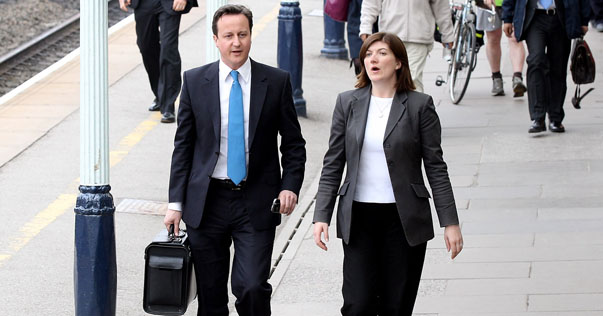The claim
 “If elected, by the end of our first Parliament I want a third of all my ministers to be female.”
“If elected, by the end of our first Parliament I want a third of all my ministers to be female.”
David Cameron, 30 April 2009
The background
Critics have called it the Conservatives’ “women problem”. A failure to promote women to top cabinet posts, and fears that the Tories are losing the female vote.
Rightly or wrongly, this week’s cabinet reshuffle has been interpreted as a strategic bid to end all that.
Mr Cameron has been taunted by the opposition at Prime Minister’s Questions after turning up with an all-male front bench.
How do the numbers stack up now?
The cabinet
There are now five women in the cabinet instead of three, following the promotion of Nicky Morgan and Elizabeth Truss.
Something odd has happened to Baroness (Tina) Stowell. She’s been promoted to leader of the house of lords, so she ought to be a cabinet member too. But the government has quietly downgraded her job so it is no longer a full cabinet post.
That means that Baroness Stowell no longer gets a cabinet salary so will get paid less than her male predecessor, Lord Hill.
It also means that David Cameron has promoted the same number of men as women to full cabinet posts, after giving the nod to Michael Fallon and Stephen Crabb.
All of this means that five out of the 22 full cabinet ministers are now women, or 22.7 per cent.
Is this good or bad? The percentage almost exactly the same as the proportion of women in the House of Commons. There are 147 female MPs out of 650, so that’s 22.6 per cent.
Comparing like with like, nine of the equivalent top 22 shadow ministers are women, which comes to 41 per cent of the front bench. There are 14 women in Labour’s full shadow cabinet team of 32, so 44 per cent.
Women make up about 51 per cent of the UK population.
The wider government
We don’t exactly know how David Cameron defined “ministers” when he made that pre-election aspiration of having women hold a third of top posters.
The government lists 136 people on its “ministers” page – including whips and peers in waiting – and 30 of them are women. Mr Cameron needs 16 more women in government to get to one third.
The Electoral Reform Society say the Prime Minister has fallen short of 33 per cent women however you cut the cake. If you only count Conservatives and you only count ministers who attend the cabinet, who comes close to the target with 31 per cent women.
Parliament
As we found in a previous FactCheck, the number of women MPs was pitifully low until the 1980s, doubled from 60 to 120 in 1997 and reached an all-time high of 147 (22.6 per cent) in 2010.
To put things in an international perspective, the United Kingdom is ranked 65th in the world for female representatives by the Inter-Parliamentary Union.
The country with the most women in MPs is Rwanda, currently on 63.8 per cent.
Labour have had more female MPs than any other party in 16 out of 18 post-war elections, but the Conservatives saw the biggest percentage increase in the 2010 election, when they went from 17 women to 49.
What happens in the next parliament?
So far, the Conservatives have selected candidates for 93 seats in the 2015 general election. Some 32 out of 93 candidates are women. That’s 34 per cent.
Of course not all seats are created equal. How many winnable seats have been given to female candidates?
We’re not aware of any perfect way of defining a safe seat, but Electoral Calculus lists all seats from the safest to the most precarious for the main parties here.
According to the website, only seven out of the 32 female Tory candidates are standing in a seat where the Conservatives are predicted to win in 2015.
Not everyone will agree with these predictions. Another way of looking at this is to see who has been given a supposedly safe seat where the incumbent is standing down due to retirement.
The Tories have 14 such seats and five women have been selected to stand in them, so that’s 35 per cent women.
Figures from the other parties are not directly comparable.
The Lib Dems told us they have 41 women standing out of 158 seats, which works out at 26 per cent overall.
Labour told us that 40 per cent of its prospective parliamentary candidates are women and 54 per cent of candidates in the party’s 106 “target seats” are women.
The party has female candidates in 14 out of 19 seats where the current Labour MP is retiring – which is 74 per cent.





